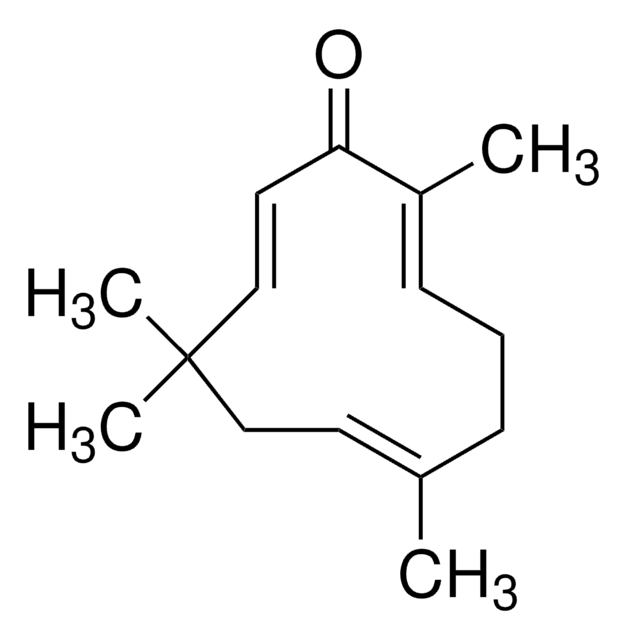Z3902
Zerumbone
≥98% (HPLC)
Sinónimos:
(2E,6E,10E)-2,6,9,9-tetramethylcycloundeca-2,6,10-trien-1-one, Zerumbone (6CI,7CI)
About This Item
Productos recomendados
assay
≥98% (HPLC)
form
powder
color
white to off-white
solubility
DMSO: ≥10 mg/mL
storage temp.
2-8°C
SMILES string
C\C1=C/CC(C)(C)\C=C\C(=O)\C(C)=C\CC1
InChI
1S/C15H22O/c1-12-6-5-7-13(2)14(16)9-11-15(3,4)10-8-12/h7-9,11H,5-6,10H2,1-4H3/b11-9+,12-8+,13-7+
InChI key
GIHNTRQPEMKFKO-SKTNYSRSSA-N
¿Está buscando productos similares? Visita Guía de comparación de productos
General description
Application
- for liquid chromatography with mass spectrometry (LC-MS-MS)
- to investigate its potential application in the prevention
- treatment of esophageal squamous cell carcinomas (ESCC)
Biochem/physiol Actions
signalword
Warning
hcodes
Hazard Classifications
Aquatic Acute 1 - Skin Sens. 1
Storage Class
11 - Combustible Solids
wgk_germany
WGK 3
flash_point_f
Not applicable
flash_point_c
Not applicable
Certificados de análisis (COA)
Busque Certificados de análisis (COA) introduciendo el número de lote del producto. Los números de lote se encuentran en la etiqueta del producto después de las palabras «Lot» o «Batch»
¿Ya tiene este producto?
Encuentre la documentación para los productos que ha comprado recientemente en la Biblioteca de documentos.
Los clientes también vieron
Artículos
Cell cycle phases (G1, S, G2, M) regulate cell growth, DNA replication, and division in proliferating cells.
Cell cycle phases (G1, S, G2, M) regulate cell growth, DNA replication, and division in proliferating cells.
Cell cycle phases (G1, S, G2, M) regulate cell growth, DNA replication, and division in proliferating cells.
Cell cycle phases (G1, S, G2, M) regulate cell growth, DNA replication, and division in proliferating cells.
Nuestro equipo de científicos tiene experiencia en todas las áreas de investigación: Ciencias de la vida, Ciencia de los materiales, Síntesis química, Cromatografía, Analítica y muchas otras.
Póngase en contacto con el Servicio técnico


![[6]-Gingerol ≥98% (HPLC)](/deepweb/assets/sigmaaldrich/product/structures/259/444/6877889c-1cc0-47f5-b807-f847deadec1d/640/6877889c-1cc0-47f5-b807-f847deadec1d.png)








